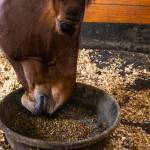Question
Mickey is my 38-year-old gelding. He’s too thin, probably a 3 on the body condition scale. He was diagnosed with Cushing’s disease and insulin resistance years ago, and kidney issues have recently been identified. He needs a diet low in nonstructural carbohydrates (NSCs), protein, magnesium, calcium, and phosphorus. He cannot have beet pulp or wheat bran. Mickey is stalled for 12 hours a day and then in a drylot the remainder of the day. Right now, he weighs about 1,000 lb (450 kg), and eats primarily a bagged forage (low in NSC; no beet pulp or grains) composed of grasses and fortified with vitamins and minerals. Mickey needs to gain weight, but I am a little lost as to where to turn.
Answer
Mickey’s condition and dietary restrictions present quite a challenge in finding an appropriate feeding program. What may work for a horse with Cushing’s might not be appropriate for a horse with kidney disease and vice versa.
Maintaining appetite is essential for underweight horses with kidney failure. If Mickey’s appetite waxes and wanes, you might have to relax his dietary restrictions a little, as getting calories into him is the priority. Choosing feedstuffs lower in protein and calcium is ideal but, when it comes to sparking his appetite, that may mean providing something more calorie-dense and palatable, like alfalfa cubes, alfalfa pellets, or oats. Offering tastier feedstuffs is a good way to get him eating consistently again. Currently, there are specialty feeds on the market that are low in NSC that can be more appealing to the picky eater as well. Once you stimulate his appetite, you can gradually shift to feedstuffs that better align with his restrictions.
You didn’t mention how much bagged forage he is getting and if any other forage sources are offered. It is important to follow the feeding directions outlined by the manufacturer to make sure his forage and nutrient needs are met. Ideally, you want him to consume around 2% of his ideal body weight in forage. If he is offered the chopped hay mix free-choice and is eating less than 1.5% of his body weight, this may be challenging given his inappetence. In terms of feed, choose a palatable feed that Mickey might like to consume. Again, if it doesn’t meet every dietary criterion, that’s okay for the time being.
As long as hyperlipidemia is not present, the current diet could easily handle more fat, which is a concentrated source of calories. Given your horse’s current body condition and age, I would not be as concerned with possible adverse effects of dietary fat on insulin resistance. You could add in vegetable oil, in addition to an appropriate omega-3 supplement to balance omega ratio. For calories, soy or canola oil is recommended over corn oil because they have a slightly better omega-3 to omega-6 ratio. You could work him up to as much oil as he will handle without going off the feed. To balance the omega-3 to omega-6 ratio that might be skewed by the addition of the vegetable oil add an omega-3 supplement, which is recommended for horses with kidney disease and metabolic problems. Omega-3s offer anti-inflammatory benefits and positive effects on glucose tolerance.
The recommended source of omega-3s is marine-derived, long-chain fatty acids. Fish oil contains DHA and EPA, omega-3s that are more efficiently used within the body than those from plant-based sources like flax. Kentucky Equine Research (KER) offers a high-quality fish oil called EO•3, which is designed to balance the ratio of omega-3 to omega-6. Just 2 ounces of this product per day will help reduce body-wide inflammation and immune support for an older horse.
With the increase in fat and because of Mickey’s kidney problems, you may consider adding an antioxidant, like the vitamin E product Nano•E, or a more complete antioxidant supplement like Preserve PS (Preserve in Australia). Adding a natural-source vitamin E is important when fresh grass (best source of E in diet) is not available.
Lastly, to aid in fiber digestion and utilization in the hindgut, I recommend the hindgut buffer EquiShure. This product has proven helpful in older horses that need to gain weight. EquiShure balances the pH in the hindgut to ensure a proper environment for fiber-fermenting microbes.








